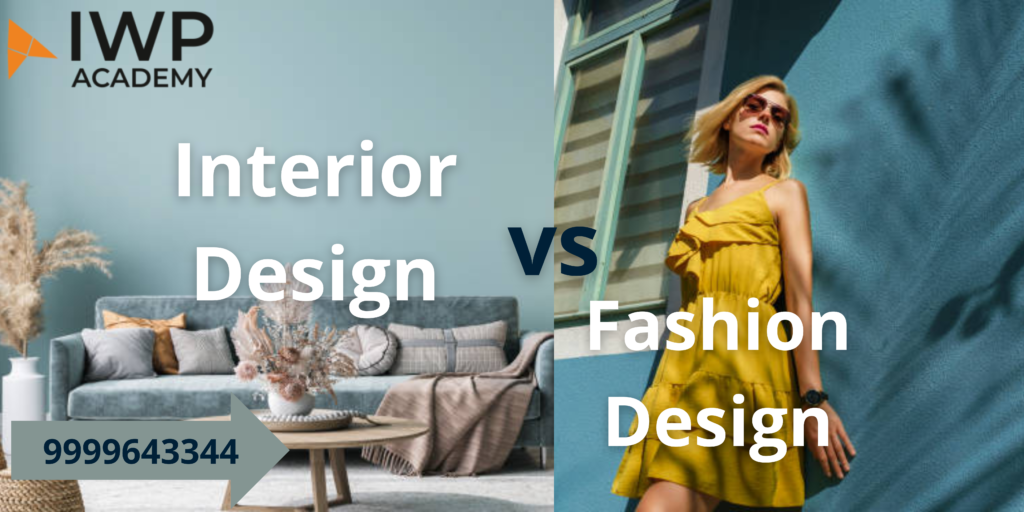Creativity knows no bounds, and it finds expression in a myriad of forms. Two such captivating avenues are interior design and fashion design. Both these fields are driven by the innate human desire to create, innovate, and transform spaces and appearances. In this blog, we will let you know about a journey to dissect the worlds of interior design and fashion design which is better.

Medium of Expression
Interior Design: The canvas of interior design extends across physical spaces. It involves shaping environments, carefully curating elements like furniture, lighting, color schemes, and textures to craft a harmonious, functional, and aesthetically pleasing space.
Fashion Design: Fashion design, on the other hand, manifests through fabrics and forms that adorn the human body. Designers play with materials, silhouettes, patterns, and accessories to create styles that reflect individuality and cultural trends.
Aesthetic Sensibilities
Interior Design: Interior designers work with spatial aesthetics, striving to balance functionality with visual appeal. They consider how various design elements interact to create atmospheres that resonate with inhabitants’ emotions and needs.
Fashion Design: Fashion designers are keen observers of trends and personal expressions. Their work involves translating cultural influences into wearable art, marrying colors, textures, and shapes to evoke emotions and make statements.
Functionality vs Wearability
Interior Design: Functionality takes precedence in interior design. The design must cater to the practical needs of the space’s occupants while still maintaining its visual allure. Ergonomics, flow, and usability are key considerations.
Fashion Design: While being wearable is important, fashion designers often push boundaries, experimenting with unconventional materials and avant-garde designs. The challenge is to achieve a balance between creativity and comfort.
Color Palettes and Textures
Interior Design: Colors and textures in interior design set the tone for a space. Designers choose from a vast spectrum of hues and textures to create moods, emphasize features, and establish a cohesive design language.
Fashion Design: Similarly, fashion designers utilize colors and textures to evoke emotions and create visual interest. Fabrics, prints, and color combinations are carefully chosen to bring their visions to life on the runway or in everyday wear.
Cultural and Trend Influences
Interior Design: Cultural and societal trends influence interior design, shaping the way spaces are configured. From minimalist Scandinavian designs to opulent Victorian aesthetics, interiors mirror the zeitgeist.
Fashion Design: Fashion is a mirror to culture too. Designers draw inspiration from history, current events, and global cultures, reinterpreting them to create collections that resonate with a diverse clientele.
Personal Expression
Interior Design: Homes are extensions of people’s personalities, and interior design allows for personal expression. Clients collaborate with designers to infuse their tastes and stories into the spaces they inhabit.
Fashion Design: Similarly, clothing is a form of self-expression. People use fashion to communicate their identities, values, and emotions, and fashion designers provide the tools to do so creatively.
Conclusion
Interior design and fashion design, while distinct in their domains, share a common thread of creative expression. Both fields embody the human desire to innovate, transcend norms, and create beauty. Whether crafting captivating interiors or clothing that speaks volumes, designers in both realms mold the world around us, weaving together functionality and aesthetics to inspire and captivate. So, whether it’s the ambiance of a room or the attire adorning a body, the magic of design continually enchants our senses.
Learn Interior Design Course and Fashion Design Course with IWP Academy






FREQUENTLY ASKED QUESTIONS (FAQS)
What is the focus of the course?
interior Design Course: This course focuses on teaching students how to design and create functional and aesthetically pleasing interior spaces. Students learn about spatial planning, furniture arrangement, color theory, materials, lighting, and more. The goal is to design interiors that meet the needs and preferences of clients while considering practical aspects.
Fashion Design Course: This course centers on the creation of clothing and accessories. Students learn about fashion trends, fabric selection, pattern-making, sewing techniques, and garment construction. The emphasis is on developing creative and artistic skills to design apparel that reflects personal style or meets industry demands.
What industries can I work in after completing the course?
Interior Design Course: Graduates can work in various industries, including residential design, commercial design (offices, hotels, restaurants), hospitality design, set design for film/TV, and even in real estate staging.
Fashion Design Course: Graduates can find opportunities in fashion houses, clothing brands, textile companies, retail, apparel manufacturing, costume design for theater/film, fashion journalism, and personal styling.
What’s the emphasis on technology?
Interior Design Course: There is a significant focus on using software like AutoCAD, SketchUp, and other 3D modeling tools for creating accurate design plans and visualizations.
Fashion Design Course: Technology is often used for creating digital fashion illustrations, pattern drafting using software like Adobe Illustrator or CAD, and even for virtual fashion shows.
